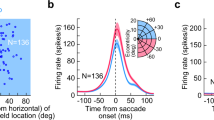Abstract
THE primate superior colliculus contains a map of saccadic eye movements1,2. Saccades are high-velocity eye movements to selected targets in the visual field, but little is known about the neural mechanisms responsible for target selection or the related problem of choosing a particular movement from the oculomotor repertoire. Two classes of neurons have been described in the superior colliculus which show bursts of activity before the saccade: discrete bursters display a vigorous pre-saccadic burst and prelude bursters3 show low-frequency activity as a prelude to burst onset. We have designed experiments to test whether prelude activity is related to saccade selection. Our tasks use a cue to specify which of two physically identical visual stimuli is the goal of an impending saccade. This cue is spatially and temporally isolated from the potential targets as well as from visual cues signalling movement initiation. Our results show that prelude activity occurs shortly after information is available for correct saccade selection and, more importantly, the activity is predictive of saccade choice. The results thus suggest that the superior colliculus participates in the process of saccade selection.
This is a preview of subscription content, access via your institution
Access options
Subscribe to this journal
Receive 51 print issues and online access
$199.00 per year
only $3.90 per issue
Buy this article
- Purchase on Springer Link
- Instant access to full article PDF
Prices may be subject to local taxes which are calculated during checkout
Similar content being viewed by others
References
Wurtz, R. H. & Goldberg, M. E. J. Neurophysiol. 35, 575–86 (1972).
Sparks, D. L., Holland, R. & Guthrie, B. L. Brain Res. 113, 21–34 (1976).
Sparks, D. L. Brain Res. 156, 1–16 (1978).
Ottes, F. P., Van-Gisbergen, J. A. & Eggermont, J. J. Expl Brain Res. 66, 465–78 (1987).
Ottes, F. P., Van-Gisbergen, J. A. & Eggermont, J. J. Vision Res. 25, 849–62 (1985).
Mays, L. E. & Sparks, D. L. Science 208, 1163–1165.
Goldberg, M. E. & Wurtz R. H. J. Neurophysiol. 35, 560–574 (1972).
Boch, R. A. & Goldberg, M. E. J. Neurophysiol. 61, 1064–1084 (1989).
Funahashi, S., Bruce, C. J. & Goldman-Rakic, P. S. J. Neurophysiol. 65, 1464–1483 (1991).
Gnadt, J. W. & Anderson, R. A. Expl Brain Res. 70, 216–220 (1988).
Sparks, D. L., Mays, L. E. & Porter, J. D. J. Neurophysiol. 58, 300–318 (1987).
Fuchs, A. F. & Robinson, D. L. J. appl. Physiol. 21, 1068–1070 (1966).
Judge, S. J., Richmond, B. J. & Chu, F. C. Vision Res. 20, 535–538 (1980).
Author information
Authors and Affiliations
Rights and permissions
About this article
Cite this article
Glimcher, P., Sparks, D. Movement selection in advance of action in the superior colliculus. Nature 355, 542–545 (1992). https://doi.org/10.1038/355542a0
Received:
Accepted:
Issue Date:
DOI: https://doi.org/10.1038/355542a0
This article is cited by
-
Correlated variability in primate superior colliculus depends on functional class
Communications Biology (2023)
-
Superior colliculus bidirectionally modulates choice activity in frontal cortex
Nature Communications (2023)
-
The Superior Colliculus: Cell Types, Connectivity, and Behavior
Neuroscience Bulletin (2022)
-
Inhibitory neurons in the superior colliculus mediate selection of spatially-directed movements
Communications Biology (2021)
-
Distinct prefrontal top-down circuits differentially modulate sensorimotor behavior
Nature Communications (2020)
Comments
By submitting a comment you agree to abide by our Terms and Community Guidelines. If you find something abusive or that does not comply with our terms or guidelines please flag it as inappropriate.



